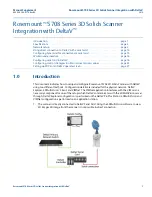
RS-232 Auxiliary Port
3-14
MS-710 Scanner User’s Manual
3–Communicat
io
ns
Daisy Chain Mode
Usage:
Used in applications where:
• A symbol might be scanned in both ladder and picket fence directions.
• A bar code symbol may be present on multiple sides of a package.
• Bar code symbols are presented at different depths.
Definition:
In a daisy chain application, scanners are connected in tandem or “daisy
chain” and decoded data is relayed from one scanner to another on up to
the host.
A master scanner has its host port linked to the host computer and its
auxiliary port linked to the host port of the first secondary scanner in the
chain. Thereafter, each secondary’s auxiliary port is linked to the host
port of the secondary that is further from the host in the daisy chain.
Each scanner in the daisy chain can be assigned an ID that accompanies
any data that it sends.
Serial Cmd:
<
Kyaux port mode
,
baud rate,parity,stop bits,data bits,daisy chain ID
status,daisy chain ID>
Options:
4 = Daisy chain
Function:
Before the master scanner times out, it checks its auxiliary port for data.
It should be set to wait at least mS for each secondary in the daisy chain.
If no data is received within the read cycle timeout, the master sends a
noread message to the host. Otherwise the complete data is sent.
If for example the master scanner is set to timeout in 120 mS, the first
secondary scanner downstream might be set to 100 mS, the next to
80 mS, and so forth, thus assuring that at least 20 mS elapses between
transmissions.
a
Daisy-chained scanners can send a series of symbols by enabling
Multi-
symbol and a common multisymbol separator. If the master scanner
does not receive the expected number of symbols, noread messages are
appended to the data string to make up the difference between the num-
ber of symbols enabled in
Multisymbol and the number of symbols read.
For example, a master and two secondary scanners have
Number of
Symbols set to 3 and Multisymbol Separator defined as %. If the
master and the first secondary scanner do not find symbols, but the next
secondary scanner registers a good read, the transmitted results would
be: symbol data % noread % noread.
a. The above example is based on the best case. Other factors such as baud rate, number of characters in
a given symbol, and the number of secondaries in the daisy chain can affect timing and may need
to be included in your calculations for complete accuracy.
Summary of Contents for MS-710
Page 1: ...MS 710 Scanner User s Manual P N 83 000700 Rev V...
Page 12: ...xii MS 710 Scanner User s Manual...
Page 22: ...1 10 MS 710 Scanner User s Manual 1 Quick Start...
Page 30: ...Send Receive Options 2 8 VS 310 Scanner User s Manual 2 Using ESP...
Page 52: ...Intercharacter Delay 3 22 MS 710 Scanner User s Manual 3 Communications...
Page 70: ...Scanner Setup 4 18 MS 710 Scanner User s Manual 4 Read Cycle...
Page 88: ...Autodiscriminate 5 18 MS 710 Scanner User s Manual 5 Symbologies...
Page 116: ...New Master Pin 7 10 MS 710 Scanner User s Manual 7 Matchcode...
Page 122: ...Terminal Window Functions 8 6 MS 710 Scanner User s Manual 8 Terminal Mode...
Page 140: ...Scanner Status Requests 9 18 MS 710 Scanner User s Manual 9 Utilities...
Page 180: ...A 40 MS 710 Scanner User s Manual Appendix...
Page 186: ...I 6 MS 710 Scanner User s Manual Index Index...
















































